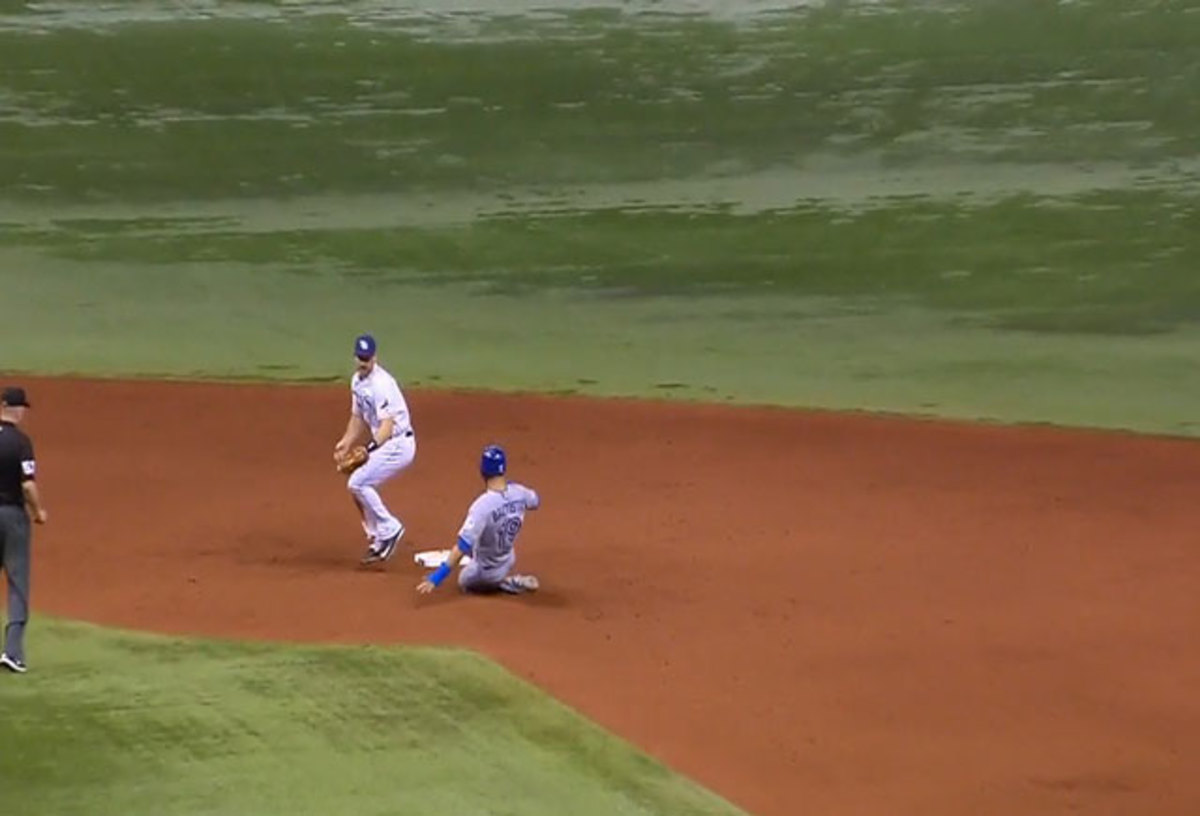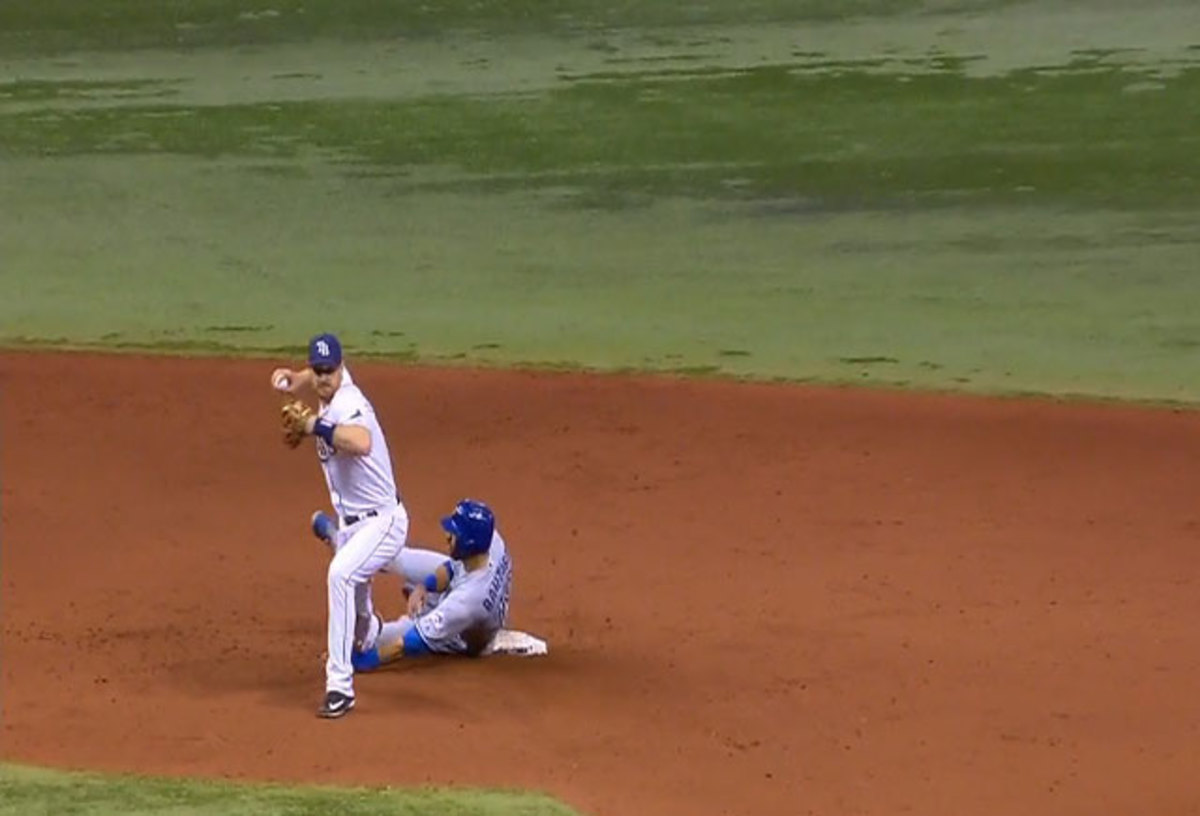Umpires right, Blue Jays wrong on controversial slide call vs. Rays

It took just three days for MLB’s new rule regarding slides intended to break up double plays to impact the outcome of a game—or so it would appear. On Tuesday night, the Blue Jays lost to the Rays when a two-run error by Tampa second baseman Logan Forsythe in the top of the ninth inning was wiped out by an interference call that cost Toronto the game.
The play came with the Jays trailing the Rays by a run in the top of the ninth with the bases loaded, one out, Jose Bautista on first base and Edwin Encarnacion at the plate. Encarnacion tapped a grounder to third base, where Evan Longoria fielded it and threw to Forsythe at second in the hope of starting a game-ending double play. Forsythe’s relay throw to first was wild, allowing both the tying and go-ahead runs to score, but upon replay review, Bautista was found to have interfered with Forsythe. As a result, Encarnacion was called out at first, both runs were negated, and the game ended in a 3–2 Rays win.
The umpires got the call right, but they didn’t need the new “Utley rule”—officially Rule 6.01(j)—to make it. In fact, Bautista’s slide was legal under the new rule. Looking at the four aspects of a legal slide defined in the rule, Bautista began his slide before reaching the base. He was well within reach of the base, sliding almost directly over it. He was able to remain on the base after completing his slide (though he did not attempt to do so, for a reason I’ll get to momentarily), and he did not change his pathway for the purpose of contacting the fielder. What Bautista did do was reach out his left hand and grab Forsythe’s foot as Forsythe was making his throw. That was blatant interference that would have, or at least should have, resulted in an identical ruling last year under the old rule, which I cited yesterday when breaking down Monday’s illegal slide by Nick Markakis.
• MORE MLB: Yankees-Astros opener turns on controversial non-call
Per the old rule, 7.09(g), which had been on the books for decades:
If, in the judgment of the umpire, a base runner willfully and deliberately interferes with a batted ball or a fielder in the act of fielding a batted ball with the obvious intent to break up a double play, the ball is dead. The umpire shall call the runner out for interference and also call out the batter-runner because of the action of his teammate.
Some have argued that Bautista’s contact with Forsythe’s foot was incidental, but I find that conclusion impossible to reach upon review of the play. Under the new rule, Bautista’s job is to slide directly into the second base and remain on the bag. Bautista did the first part, but he then made a very obvious reach toward Forsythe, not the base. Consider these two freeze-frames, the first one as Bautista begins his slide:

And the second as he finishes:

In the first image, Bautista is making a legal slide directly toward the base. In the second, he is clearly making a concerted effort to reach toward Forsythe rather than to maintain contact with the base.
New 'Chase Utley rule' on slides passes first test on Opening Day
That’s a violation not only of the updated “Utley rule,” but also of MLB's longstanding interference rules. It’s one thing when a runner’s momentum caries his body into a fielder, but when he extends a limb toward the fielder, all doubts about his intent are erased. Such an action is covered explicitly in the new rule, prohibiting the runner from “throwing his arm” in an attempt to “intentionally initiate (or attempt to initiate) contact with the fielder.” Bautista made a blatant effort to interfere with Forsythe, and he cost his team the game in the process.
Unfortunately and unsurprisingly, because the rule regarding such plays has been updated this year, the fallout from this play has focused not on Bautista’s poor decision making but on the new rule. Allow me to repeat what I wrote yesterday: Breaking up a double play has always been illegal. Read the old rule I quoted above again; I’ll simplify it for you: “If a base runner deliberately interferes with a fielder with the obvious intent to break up a double play,” the ball is dead and both runners are out.
Rather than calling Rule 6.01(j) a new rule, we should instead call it a newly worded version of the old rule. The reason it needed to be reworded was because Rule 7.09(g) was not being enforced by the umpires. Because of that failure on their part, MLB felt it necessary to reword the rule with language explicitly outlining the parameters of legal and illegal actions on the part of the runner. If anything, that language should make it easier for runners to avoid violating the rule, as they now know exactly what it is they cannot do. Among the things they cannot do: attempting to initiate contact by kicking a leg or throwing an arm at the fielder, which Bautista should have known. He also should have known that in this era of instant replay, there are no more covert actions on the field.
• MORE MLB: Dominant bullpens are making art of comeback rare
As for John Gibbons’s sexist postgame comments—he suggested that if that is how the game is going to be played (which is to say, according to the actual rules), “maybe we’ll come out wearing dresses tomorrow"—I refer you to a tweet from Jays fan and Globe and Mail columnist Stacey May Fowles. “The sheer number of people who think it’s totally okay to use women as a quick and easy metaphor for baseball weakness is astounding," she wrote.
Gibbons should have found it far more emasculating to complain that his team wasn’t allowed to cheat when its cleanup hitter hit into a game-ending double play than for the umpires to call the interference rule that has long been a part of baseball. Ultimately, that is the impetus behind both the home plate collision and second base slide rules: getting the umpires to enforce the interference and obstruction rules that were already on the books. Baseball is not and never was intended to be a contact sport. The umpires got it right on Tuesday night. Bautista and Gibbons got it very, very wrong.
